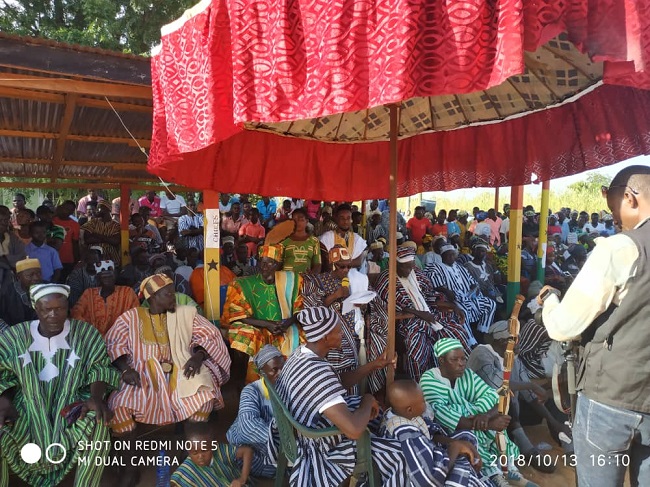The Chief Linguist for the Paramount Chief of Bongo Traditional area in the Upper East region of Ghana known as Kana has revealed in details the historical background of the Azambene festival including how it all started, its impact and why it needs to be celebrated yearly in Bongo.
As the people of Bongo celebrate the one and most important festival on the 30th of August, 2020, Bolganews.com paid a visit to the town to ascertain facts and deeper understanding about the famous festival in the region.
Speaking to us was the chief linguist known as the ‘KANA’ who spoke on behalf of the paramount chief and Hon Atindaana Emmanuel the chairman for the Azambene festival; they took their time to explain to us in details.
According to the Kana, the festival marks the origin of Bongo as a community as well as the victorious battle fought by their ancestors Awubgo and Asikulka to take the land away from its first occupants, (the busaasi).
He explained that it all happened long time ago, more three hundred (300) years ago when the people who occupy the present day Bongo were living in Mampurugu in the Northern region of Ghana. At that time one of them known as Awubgo who was a hunter discovered the Bongo land during one of his hunting expeditions. He realized that the land was so fertile but the occupants were not friendly to him due to language barrier and this compelled him to go back to the Nayire (chief palace) in Mampurugu land to solicit for support in order to fight the Busaasis and take over the land.
Upon reaching a river where he was to cross before he gets to the chief palace, all the people who were around the river fled in fear of him because of his hunting dress, it was only the youngest person among them known as Issah who refused to run away, Awubgo then requested for water from him and asked of his house, then the boy gave him the water and told him that he was from the chief palace. Awubgo then proceeded to the chief palace and narrated his experience at Bongo as well as his desire to take the land away from the Busaasi. He told him that he saw a land somewhere far away but the people are not friendly to him, in the local dialect, he said; ‘mam nye la tinga nboonsa ti ka ana sunga dee ti neriba la mi kata mam’.
The chief then assured him of his support and they went to bed, the following morning, the chief called all his sons together and asked Awubgo to choose any of them to go and help him fight the Busaasi, he looked through all of them and chose the ‘small’ boy who gave the water to him at the river (Issah). This surprised the chief and he sought for explanation. Awubgo then disclosed his encounter with the boy at the river describing him as a brave person.
The chief then handed over the boy to him, but before they set off, the boy asked the chief this inspiring question; now that you have handed me over to him and we are going for a battle how are we going to win the fight? The chief then told him that his father ever said to him that when they are going for a fight, they don’t enter the land in the day time but in the night and when you are at your hideout waiting for night to fall, make bundles of dry grass and tie them in the form of circles and wait for midnight so that you hung the bundles of grass on trees at advantage points, light them up with fire and fire gun shots.
Awubgo and the boy took this advice and did same. In the middle of the night, they placed the bundles of grass on trees at vantage points, lit them up and fired gun shots, the people run out of their homes and fled without taking any of their belongings. Awubgo and his boy then monitored the place for three days and nobody returned there, so without struggle or bloodshed, they conquered the land with the help of fire so they used the fire to jubilate their victory.
When they got back to their hideout, they saw a python known in the local language as ‘Bohungo’ which is a harmless python. So considering his initial statement at the chief palace; (‘mam nye la tinga nboonsa) and the name of the python they saw at their hideout (Bohungo), he named the place after the python. So the original name of the community was ‘Bohungo’ but because the white man came and couldn’t mention the name well they called it Bongo hence the current name.
According to the chairman of the Azambene festival committee, Hon Atindaana, the fact that they fought the battle without bloodshed and the discovery of the harmless python, it symbolizes peace hence Bongo is recognized as one of the most peaceful traditional enclaves in the upper east region.
After the three days of monitoring the place, they returned to the chief palace at Manprugu land to give the chief the good news, the chief congratulated them and decided to install Awubgo as chief to come back and control the Bongo land but Awubgo pleaded with him to install the boy as chief over the land.
The chief agreed and asked for a name to be given to the boy and Awubgo gave him the name Asikulka saying that it’s because of their encounter at the river that brought them that far. Awubgo then returned to the Bongo land and settled there with Asikulka as the chief while he continued with his hunting business through which he discovered another land somewhere and settled there, now is the present Zorko land.
MODE OF CELEBRATION
The celebration of the festival takes place in two days, it begins in the night where the paramount chief fires a gun shot in the night then the people light up fire and go out shouting ‘heeehe aditige’ meaning they are happy that they will eat to their satisfaction so the original phrase was ‘nditige’ but the gathering of people and the celebration is what is known as Azambene/zama bene. The fire signifies what Awubgo did to secure the victory. So after moving round with the fire, they role it round their heads three times and throw them into the river, go back home and wash their hands and feet signifying cleansing.
Then the main celebration; dancing, eating and merry making continues the following day after the performance of sacrifices.




